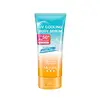What's inside
What's inside
 Key Ingredients
Key Ingredients

 Benefits
Benefits

 Concerns
Concerns

 Ingredients Side-by-side
Ingredients Side-by-side

Water
Skin ConditioningAlcohol Denat.
AntimicrobialEthyl Methoxycinnamate
UV AbsorberButylene Glycol
HumectantDipropylene Glycol
HumectantDimethicone
EmollientSteareth-6
EmulsifyingOctocrylene
UV AbsorberDiethylamino Hydroxybenzoyl Hexyl Benzoate
UV FilterCarbomer
Emulsion StabilisingAcrylates/C10-30 Alkyl Acrylate Crosspolymer
Emulsion StabilisingParaffinum Liquidum
EmollientCannabis Sativa Seed Extract
EmollientSqualane
EmollientSodium Hyaluronate
HumectantXanthan Gum
EmulsifyingDisodium EDTA
Sodium Hydroxide
BufferingTriethanolamine
BufferingBHT
AntioxidantPhenoxyethanol
PreservativeMethylparaben
PreservativeParfum
MaskingWater, Alcohol Denat., Ethyl Methoxycinnamate, Butylene Glycol, Dipropylene Glycol, Dimethicone, Steareth-6, Octocrylene, Diethylamino Hydroxybenzoyl Hexyl Benzoate, Carbomer, Acrylates/C10-30 Alkyl Acrylate Crosspolymer, Paraffinum Liquidum, Cannabis Sativa Seed Extract, Squalane, Sodium Hyaluronate, Xanthan Gum, Disodium EDTA, Sodium Hydroxide, Triethanolamine, BHT, Phenoxyethanol, Methylparaben, Parfum
Water
Skin ConditioningOctocrylene
UV AbsorberPropylene Glycol
HumectantEthylhexyl Salicylate
UV AbsorberButyl Methoxydibenzoylmethane
UV AbsorberDibutyl Adipate
EmollientC12-15 Alkyl Benzoate
AntimicrobialIsohexadecane
EmollientDiethylhexyl Butamido Triazone
UV AbsorberPhenoxyethanol
PreservativeGlyceryl Stearate
EmollientPEG-100 Stearate
Cetearyl Alcohol
EmollientPotassium Cetyl Phosphate
EmulsifyingTitanium Dioxide
Cosmetic ColorantPolyacrylamide
Menthol
MaskingSilica
AbrasiveC13-14 Isoparaffin
EmollientChlorphenesin
AntimicrobialSilica Dimethyl Silylate
EmollientXanthan Gum
EmulsifyingMethyl Diisopropyl Propionamide
MaskingDisodium EDTA
Acrylates/C10-30 Alkyl Acrylate Crosspolymer
Emulsion StabilisingNiacinamide
SmoothingAloe Barbadensis Leaf Juice
Skin ConditioningCucumis Sativus Juice
EmollientSodium Hydroxide
BufferingCarbomer
Emulsion StabilisingLaureth-7
EmulsifyingPotassium Sorbate
PreservativeBiosaccharide Gum-4
Skin ConditioningSodium Sulfite
PreservativeWater, Octocrylene, Propylene Glycol, Ethylhexyl Salicylate, Butyl Methoxydibenzoylmethane, Dibutyl Adipate, C12-15 Alkyl Benzoate, Isohexadecane, Diethylhexyl Butamido Triazone, Phenoxyethanol, Glyceryl Stearate, PEG-100 Stearate, Cetearyl Alcohol, Potassium Cetyl Phosphate, Titanium Dioxide, Polyacrylamide, Menthol, Silica, C13-14 Isoparaffin, Chlorphenesin, Silica Dimethyl Silylate, Xanthan Gum, Methyl Diisopropyl Propionamide, Disodium EDTA, Acrylates/C10-30 Alkyl Acrylate Crosspolymer, Niacinamide, Aloe Barbadensis Leaf Juice, Cucumis Sativus Juice, Sodium Hydroxide, Carbomer, Laureth-7, Potassium Sorbate, Biosaccharide Gum-4, Sodium Sulfite
Ingredients Explained
These ingredients are found in both products.
Ingredients higher up in an ingredient list are typically present in a larger amount.
Acrylates/C10-30 Alkyl Acrylate Crosspolymer is a synthetic polymer. It is used to thicken and improve the texture of products. Due to its properties, it can prevent water and oil ingredients from separating.
Carbomer is a polymer of acrylic acid. Its main role is to create a gel consistency.
A high amount of carbomer can cause pilling or balling up of products. Don't worry, most products contain 1% or less of carbomer.
Disodium EDTA plays a role in making products more stable by aiding other preservatives.
It is a chelating agent, meaning it neutralizes metal ions that may be found in a product.
Disodium EDTA is a salt of edetic acid and is found to be safe in cosmetic ingredients.
Learn more about Disodium EDTAOctocrylene protects skin from sun damage. It absorbs UV-B with peak absorption of 304 nm. It is a common sunscreen ingredient and often paired with avobenzone, a UVA filter. This is because octocrylene stabilizes other sunscreen ingredients by protecting them from degradation when exposed to sunlight. Octocrylene is a photostable ingredient and loses about 10% of SPF in 95 minutes.
Octocrylene also acts as an emollient, meaning it helps skin retain moisture and softens skin. It is oil-soluble and hydrophobic, enhancing water-resistant properties in a product.
Those who are using ketoprofen, a topical anti-inflammatory drug, may experience an allergic reaction when using octocrylene. It is best to speak with a healthcare professional about using sunscreens with octocrylene.
The EU allows a maximum of these concentrations:
Learn more about OctocrylenePhenoxyethanol is a preservative that has germicide, antimicrobial, and aromatic properties. Studies show that phenoxyethanol can prevent microbial growth. By itself, it has a scent that is similar to that of a rose.
It's often used in formulations along with Caprylyl Glycol to preserve the shelf life of products.
Sodium Hydroxide is also known as lye or caustic soda. It is used to adjust the pH of products; many ingredients require a specific pH to be effective.
In small amounts, sodium hydroxide is considered safe to use. However, large amounts may cause chemical burns due to its high alkaline.
Your skin has a natural pH and acid mantle. This acid mantle helps prevent harmful bacteria from breaking through. The acid mantle also helps keep your skin hydrated.
"Alkaline" refers to a high pH level. A low pH level would be considered acidic.
Learn more about Sodium HydroxideWater. It's the most common cosmetic ingredient of all. You'll usually see it at the top of ingredient lists, meaning that it makes up the largest part of the product.
So why is it so popular? Water most often acts as a solvent - this means that it helps dissolve other ingredients into the formulation.
You'll also recognize water as that liquid we all need to stay alive. If you see this, drink a glass of water. Stay hydrated!
Learn more about WaterXanthan gum is used as a stabilizer and thickener within cosmetic products. It helps give products a sticky, thick feeling - preventing them from being too runny.
On the technical side of things, xanthan gum is a polysaccharide - a combination consisting of multiple sugar molecules bonded together.
Xanthan gum is a pretty common and great ingredient. It is a natural, non-toxic, non-irritating ingredient that is also commonly used in food products.
Learn more about Xanthan Gum